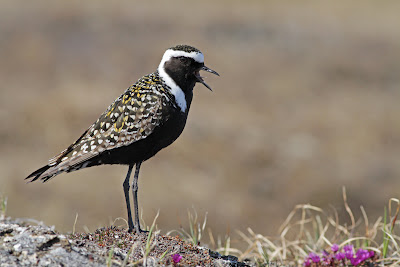"Blondie" as we called him, about a mile away through a telescope, with the icebergs in the Arctic Ocean visible behind him
The last thing I saw before I
entered my tent a couple minutes ago was a grizzly bear. It is after midnight,
and I have spent the past couple hours or so watching a massive male bear feeding on the next ridge over from camp, a mile or so away. So, not quite as
menacing as the first sentence sounded, but I’ll take it nonetheless.
This individual is very blonde,
with a pale golden body offset by darker legs and muzzle. He is also a complete
beast, with enormous shoulder muscles that ripple when he walks, visible from
even a mile away, and just overall a hulking large animal. We watched him dig
for lemmings, which consisted of him wandering around the tundra, periodically
using his dinner-plate sized paws to tear up chunks of tundra the size of human
torsos with about as much effort as flipping a coin. The ease with which he
churned through the hard-packed ground was nothing short of impressive, a swift
backhand from one of those same paws could surely send a human flying!
Part of the reason why we watched him for so long was so that we could be sure he wasn’t coming towards camp, since he halved his
distance from us in the initial hour or so that we were watching. Once he
started to head away everyone else went to bed, but I wanted to go
photographing in the gorgeous light again so I went out alone. I ended up only
being out for a brief while since my Buff-breasted Sandpiper quarry from a few
nights ago were nowhere to be found. However, it was definitely quite an
experience being out there alone knowing that there is a bear waltzing along a
mile or so away.
A beautiful night to be out! The shadows are long at midnight.
Baird's Sandpiper right below camp after dinner
The other big news today is also of
the mammalian persuasion – this one less menacing – in the form of caribou! Out
working today we had had a half-dozen or so caribou, more than any other day
leading up to now. Upon returning to camp at 6:30pm or so I took a look inland
up the river floodplain, and as I scanned I saw dozens, then hundreds, and
eventually over a thousand caribou, strung out along the horizon – an amazing
spectacle.
Normally the big herds don’t move
coastward until later in the summer, when they’re driven to the colder and
windier river deltas and coasts by the tremendous numbers of biting insects. The
insects that plague the caribou come in a few flavors, the most well known of
which are mosquitoes. In addition, they also cultivate a few kinds of parasitic
flies that make their lives miserable, but the mosquitoes can be so dense up
there that the caribou can actually die of low blood pressure due to blood
loss. A pretty inconceivable concept to life down here!
These herds can number in the tens
of thousands, with over 50,000 being seen here a couple years ago. Normally
numbers like this don’t arrive until at least August if they’re going to at
all, but perhaps the very warm temperatures (50°F+ today again) have galvanized
the animals into action due to an early bug hatch. Time will tell!
American Golden-Plover, one of the more striking birds in the area in my opinion






1 comment:
Great images once again. The Plover is really nice. If a bear or fox came close to the tents would the electric fence be an adequate deterrent? That bear was scary and huge.
Post a Comment